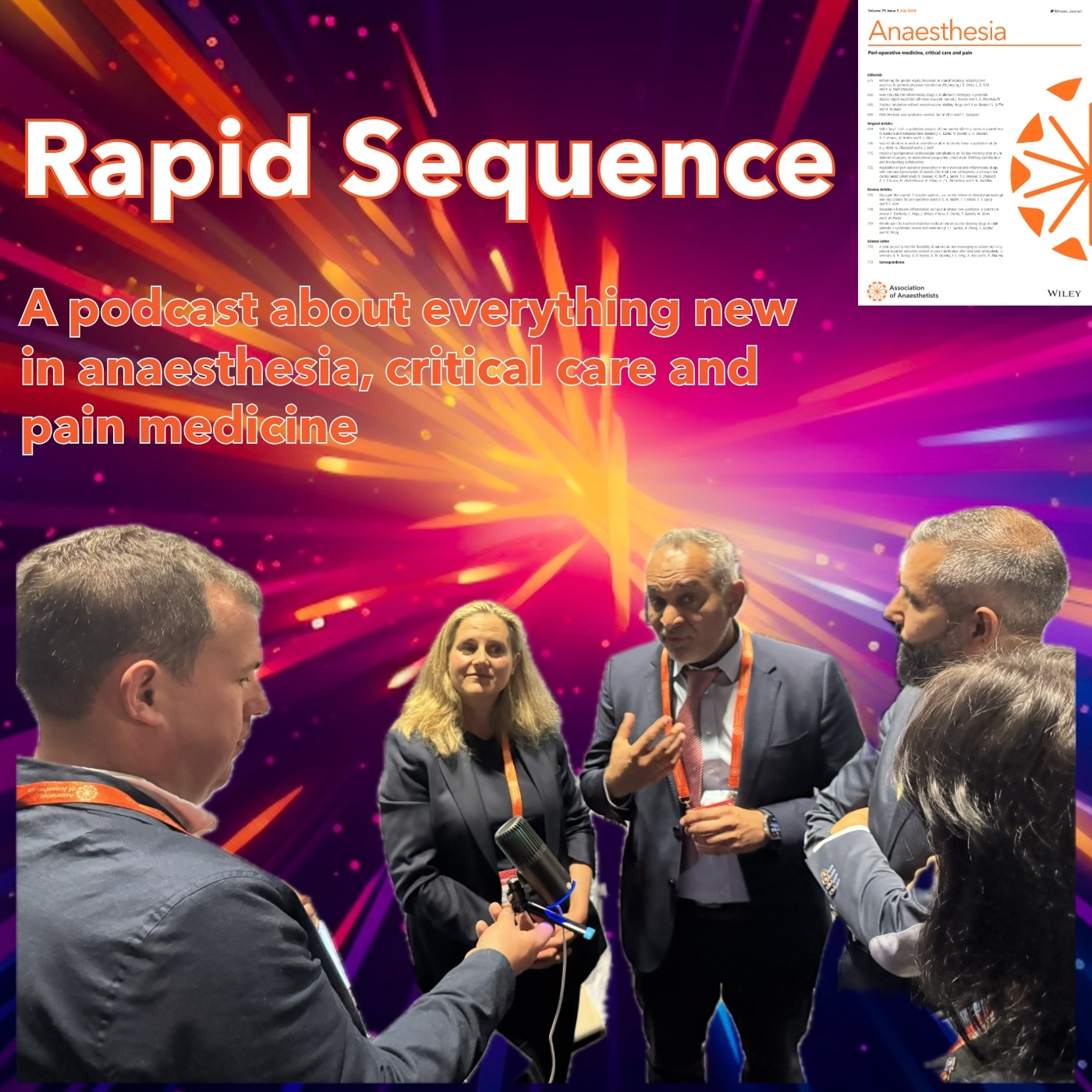
79.9K
Downloads
79
Episodes
Anaesthesia is the official journal of the Association of Anaesthetists and is international in scope and comprehensive in coverage. It publishes original, peer-reviewed articles on all aspects of general and regional anaesthesia, intensive care and pain therapy, including research on equipment. Rapid Sequence podcasts offer an insight into our journal, publications, editors, reviewers, authors and readers. Each episode is short, concise and packed full of CPD for all your educational needs.
Episodes
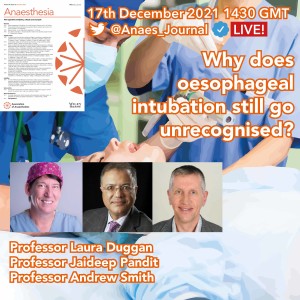
Sunday Dec 19, 2021
Why does oesophageal intubation still go unrecognised?
Sunday Dec 19, 2021
Sunday Dec 19, 2021
A recent coroner’s report in the UK concluded that a healthy patient died as a result of unrecognised oesophageal intubation. This did not seem to be the result of misinterpretation of a flat end-tidal carbon dioxide trace, but an apparent omission to check the capnograph after intubation and to perform clinical checks of tracheal tube position.
This podcast accompanies a new editorial from Pandit, Young and Davies which highlights the main lessons that can be learned from this tragic event.
Joining Professor Pandit we are delighted to have with us Professors Laura Duggan and Andrew Smith. The tread from Tanya Selak to accompany the podcast can also be found here.
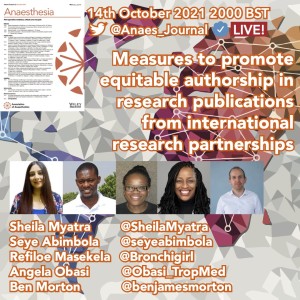
Friday Oct 15, 2021
Friday Oct 15, 2021
Parachute (or ‘helicopter’) research is the practice of conducting primary research within a host country and subsequently publishing findings with inadequate recognition of local researchers, staff and/or supporting infrastructure.
Joining our Associate Editor Sheila Myatra was Seye Abimbola, Refiloe Masekela, Angela Obasi and Ben Morton who are authors of the paper.
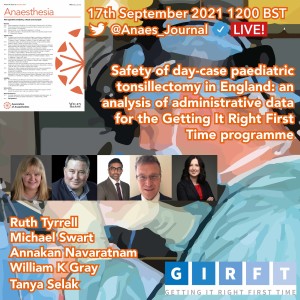
Tuesday Sep 21, 2021
Tuesday Sep 21, 2021
In the UK, the Getting It Right First Time (GIRFT) programme was established by the Department of Health and Social Care as an initiative to investigate variation in healthcare delivery and patient outcomes between hospital Trusts in England. Variation between Trusts is unwarranted unless justified by patient case-mix, patient preference, equivocal evidence of effectiveness of a particular patient management approach or intractable resource constraints.
This new paper used the Hospital Episodes Statistics (HES) database to investigate variation in the rates Trusts discharged children the same day after tonsillectomy and associations with adverse postoperative outcomes. They found evidence that outcomes for day-case and overnight stay tonsillectomy are similar and conclude the majority of specialist and non-specialist Trusts should increase day-case surgery rates.
Joining the authors today was our chair Tanya Selak who is an Associate Editor as well as Ruth Tyrrell from GIRFT.
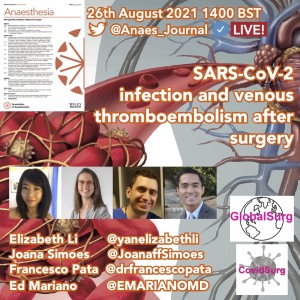
Monday Aug 30, 2021
SARS-CoV-2 infection and venous thromboembolism after surgery
Monday Aug 30, 2021
Monday Aug 30, 2021
Robust evidence is needed to enable clinicians and policymakers to minimise VTE risk in patients with SARS-CoV-2 infection. Ideally, such evidence would stratify the risk of VTE against both the duration of time between infection and surgery and presence or absence of symptoms. This study aimed to determine the VTE rate in patients with SARS-CoV-2 infection, stratified by current or prior infection.
The authors found that SARS-CoV-2 infection was independently associated with an increased incidence of postoperative VTE in patients with peri-operative and recent SARS-CoV-2 infection. In patients with pre-operative SARS-CoV-2, ongoing symptoms were associated with an increased rate of postoperative VTE, irrespective of how long before surgery the diagnosis was made.
For this live podcast, Anaesthesia Editor Ed Mariano was joined by Elizabeth Li, Joana Simoes and Francesco Pata from the authorship group. They discuss the main findings, strengths, limitations, clinical applications and much more! Enjoy!
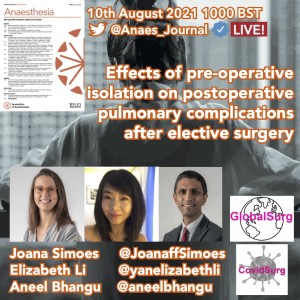
Thursday Aug 12, 2021
Thursday Aug 12, 2021
This international prospective cohort study analysed data on > 96k patients from > 1500 hospitals in > 100 countries. They found that the overall postoperative pulmonary complication rate for all patients was 2.0%, which alone is useful to know. Perhaps more strikingly, and following adjustment for various measured confounders, patients who isolated had a 20% increased risk of postoperative pulmonary complications. The risk climbed to 31% more in those isolating ≥ 8 days, which is still shorter than current periods recommended in England for certain patient groups.
The question is, can these new data be used to update guidelines and clinical practice, resulting in at once improved safety, outcomes, efficiency and patient experience?
Joining us today we have Joana Simoes, Elizabeth Li and Aneel Bhangu from the authorship group.
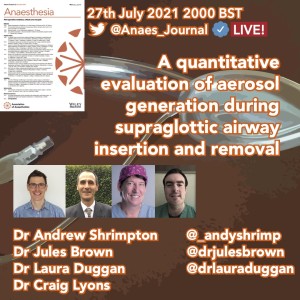
Thursday Jul 29, 2021
Thursday Jul 29, 2021
The WHO has developed a list of aerosol-generating procedures that healthcare organisations throughout the world have used as a framework for development of their guidelines. Supraglottic airways are used in the majority of the approximately 2.7 million general anaesthetics performed in the UK each year. In a UK survey in October 2020, 40% of responding hospitals reported that supraglottic airway removal, even in low COVID-19 risk pathways, is restricted exclusively to the operating theatre (rather than being performed in a recovery area), indicating the presence of policies that assume it is an aerosol-generating procedure. However, uncertainty remains as to whether insertion or removal of a supraglottic airway generates aerosols.
Given the uncertain balance of potential risks and benefits associated with the protective strategies put in place to limit airborne viral transmission, this new paper from Shrimpton et al. aimed to directly assess airborne particle emission during insertion and removal of supraglottic airways. They used real-time measures of aerosol generation with an optical particle sizer in a working operating theatre environment and compared the measured levels with reference to those generated by a volitional cough and the patient’s own breathing.
Joining two of the authors was our fellow, Craig Lyons as well as Laura Duggan who is an Editor of Anaesthesia.
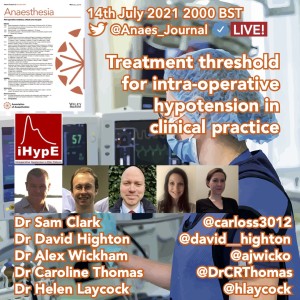
Thursday Jul 15, 2021
Thursday Jul 15, 2021
Intra-operative hypotension frequently complicates anaesthesia and has been extensively associated with myocardial injury, acute kidney injury, stroke and death. The iHypE study aimed to describe the incidence of intra-operative hypotension in older patients and define both the intended blood pressure treatment threshold, and the clinically applied treatment threshold for intra-operative hypotension in UK anaesthetic practice.
The main finding was that intra-operative hypotension is documented in the majority of patients aged ≥ 65 y undergoing surgery in the UK using any of the applied definitions. Prolonged intra-operative hypotension was also prevalent in most patients.
This podcast discusses the how the study was done as well as its key clinical implications. It is essential listening for anyone interested in conducting a trainee network research project and the story of how such a study was coordinated and run is fascinating.
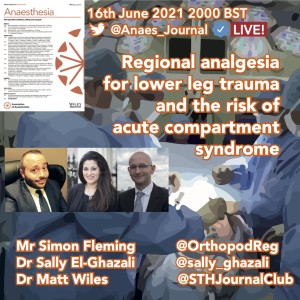
Friday Jun 18, 2021
Friday Jun 18, 2021
Tonight’s discussion is all about a new Association of Anaesthetists guideline on regional analgesia for lower leg trauma and the risk of acute compartment syndrome.
Pain resulting from lower leg injuries and consequent surgery can be severe. There is a range of opinion on the use of regional analgesia and its capacity to obscure the symptoms and signs of acute compartment syndrome. There is, however, very little high quality evidence to inform practice. These guidelines were developed, therefore, to provide pragmatic guidance to enable optimal analgesia and to highlight the need for careful observation for acute compartment syndrome in any patient at risk.
With us today to discuss this new paper we have one of the authors, Dr Matt Wiles from Sheffield, who is also an Editor of Anaesthesia. With us also we have Mr Simon Fleming who is a trainee Trauma and Orthopaedic surgeon who has developed a national, and growing international reputation, for his campaigning work to drive cultural change in the NHS and other healthcare organisations. Last but by no means least we have Dr Sally El-Ghazali who is a London based anaesthetist and intensive care doctor, and the immediate past chair of the Association of Anaesthetists Trainee committee
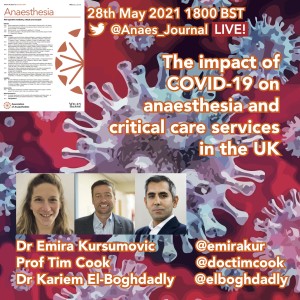
Tuesday Jun 01, 2021
The impact of COVID-19 on anaesthesia and critical care services in the UK
Tuesday Jun 01, 2021
Tuesday Jun 01, 2021
During the COVID-19 pandemic, there has been considerable focus on the escalation of critical care capacity, capability and delivery. Early in the first wave, NAP7 was postponed and, as part of assessing when anaesthetic and peri-operative services might have returned to a stable baseline and thus be ready for starting NAP7, the authors of this new paper undertook a series of national surveys in order to track activity during the second wave of the pandemic.
Their work describes and quantifies the huge pressures on the anaesthesia and critical care workforce during the winter wave of the pandemic, and the devastating drop in surgical activity.
Joining us today we have Dr Emira Kursumovic and Professor Tim Cook. Their work was published just last week, is highly relevant to hospitals, healthcare staff and patients alike, and was featured in the mainstream media.
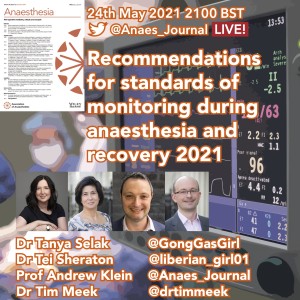
Wednesday May 26, 2021
Recommendations for standards of monitoring during anaesthesia and recovery 2021
Wednesday May 26, 2021
Wednesday May 26, 2021
This guideline updates and replaces the 5th edition of the Standards of Monitoring published in 2015. The aim of this document is to provide guidance on the minimum standards for monitoring of any patient undergoing anaesthesia or sedation under the care of an anaesthetist. The recommendations are primarily aimed at anaesthetists practising in the UK and Ireland, but it is recognised that these guidelines may also be of use in other areas of the world.
For this podcast, Tanya Selak joined us from Australia with authors Andrew Klein, Tim Meek and Tei Sheraton. This one is not to be missed! Enjoy!
